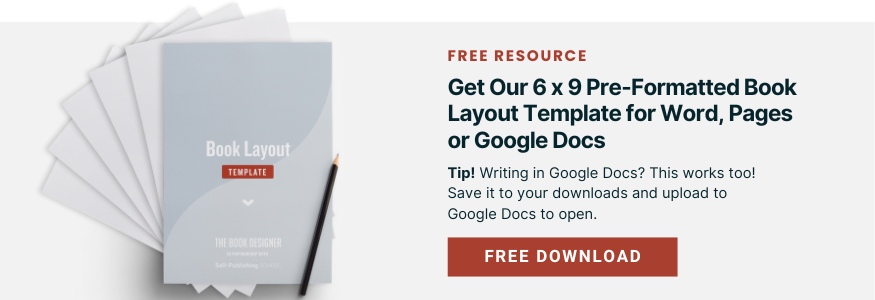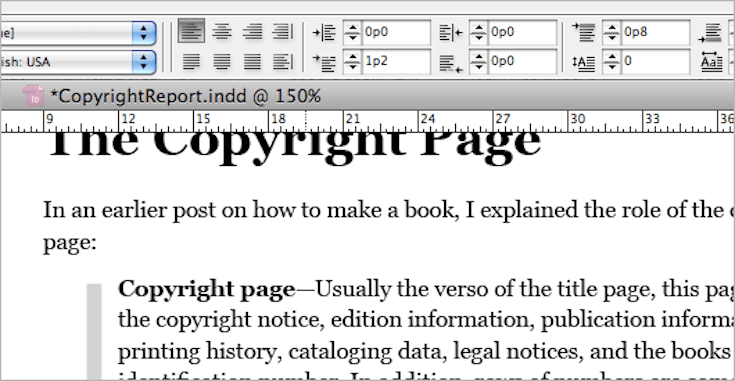You’re an author, and you want to self-publish. After all, the juice seems to be flowing toward self-publishers, more authors are rethinking their approach to publishing, and new opportunities seem to be opening up to self-publishers every day.
The indie spirit in self-publishing leads lots of authors to want to take ownership of the entire process of book making, not just the writing. For most people trying to create a truly professional-looking book, the best solution will be to simply hire a professional.
But there’s no reason you can’t produce a reasonable-looking book if you’re willing to put in the time and educate yourself about books, and about the software you’ll use to create your book.
Here’s a guide to help you get oriented to this task if you decide to do it yourself.

Guide to Book Design & Page Layout Software
There are three levels of software generally available to you if you decide to go the DIY book formatting route:
- Word processors—Microsoft Word has long had a chokehold on the word processing market due to its complete domination of the corporate environment. And don’t forget all those PCs that came with MS Office pre-installed on them.
Most people use Word, and we also have the useful open source Open Office that reads and writes Word files, too. Other choices in this range include Apple’s Pages; Storyist and Scrivener, word processors that are also story development tools; Word Perfect, the old PC warhorse still in production, and a host of others. These are the programs writers are most familiar with, and in which you’ve probably spent the last couple of years writing your book.
- Layout programs—Since the advent of “desktop publishing” programs have been available that perform the functions usually taken care of by a layout artist.
Now we have programs like Adobe InDesign and Quark Xpress to perform these functions. They allow you to bring together all the parts of a publication and manipulate them, then output the resulting job to a variety of devices for reproduction.
- Hybrids—There is also a midrange type of software that attempts to combine the word processing functions with layout functions. For instance, Microsoft Publisher is popular for flyers, business brochures and similar projects, and there are a lot of templates available to make creating jobs easier.
Likewise, Apple’s Pages is really a hybrid and can be used either as a word processor or as a layout engine, depending on the type of document you create. This category is showing the most growth in recent months, with more programs coming onto the market that attempt to be “all things to all people.”Now Pages offers EPUB output, as does Storyist. Any program that provides a clean word processing environment as well as the ability to combine text, graphics and output to reproduction devices might fall into this category.
Which Option is Right For You?
It’s pretty seductive to use your word processor for putting your book together. After all, you’re already familiar with the program and that should save you a ton of time. But a word processor is a poor choice for some kinds of books:
- Illustrated books—It can be very frustrating to try to position graphics with any precision in a word processor. These programs usually lack sophisticated color-handling also, limiting their use for illustrated books.
- Heavily formatted books—The more formatting involved, like sidebars, pull quotes, tables, charts, illustrations and anchored graphics, the less appropriate a word processor is as a layout solution.
- Typographically sophisticated books—Word processors do not have the very fine typographic controls you find in sophisticated layout programs. And hyphenation and justification of text simply will not look as polished as it would in dedicated software.
Pros and Cons for Each Type of Software
No matter what you choose to use as a vehicle to publish your book, there are tradeoffs. They are not always apparent, and might not affect you from day one of your project, but before you lock yourself into one solution or another, consider these:
- Word processors, Pro and Con
- Pro: You already know how to use it
- Pro: The least expensive of the three alternatives, particularly if you already own it.
- Pro: The shortest learning curve of the three types of programs
- Con: You may not know how to use the functions you’ll need to do your book.
- Con: Get ready to be frustrated if you’re trying to do exact placement of images on your pages
- Con: Your options to output your pages may be severely limited, and you’ll have no support for color corrections, color calibration or many other advanced functions needed for some kinds of books.
- Hybrids, Pro and Con
- Pro: Less expensive than dedicated layout programs.
- Pro: Easier to learn than dedicated layout programs.
- Pro: Pre-built templates are available to get you started.
- Con: Compromised functions of both word processors and layout programs may fail to satisfy or give the range of options of either type of program separately.
- Con: Idiosyncratic. These programs may use “dumbed down” functions and language to describe the processes in an attempt to appeal to the widest variety of users.
- Con: You may be frustrated by the availability of some, but not all, the functions of a higher-level layout program.
- Layout programs, Pro and Con
- Pro: You get complete control of your pages, with precise placement of all elements.
- Pro: Robust support for output to all kinds of reproduction devices from low-end to high-end reproduction
- Pro: Huge market of add-on and supplemental programs that supply even more functionality to these programs, and integrate with image editing functions as well.
- Con: These babies are expensive to buy, and if you will only do one book, it may be hard to justify the expense.
- Con: If you haven’t used this type of software before, get ready for some intensive training. And you can start by trying to figure out what a “pica” is.
- Con: The variety and precision of commands and functions can be overwhelming for new users.
Recommendations
What kind of software you end up using to do your book will rely on lots of factors. But generally speaking, I would recommend:
- Word processors if you’re on a budget, if your book is basically running text without much formatting, or if you only want to print up a few books for private use. You can dedicate yourself to learning how to manipulate these programs into producing a decent-looking book, but it may not be the best use of your time. Microsoft Word remains my choice here.
- Hybrid programs if you’re willing to pay a few dollars for software that will give you a lot more flexibility with page layout, effects, placement of non-text elements. And if you are only a casual user, these programs will be easier to learn. I’m impressed with Apple’s Pages for layout and output to EPUB.
- Page layout programs if you foresee doing more than one book a year, you like the idea of learning printing terms and procedures, or if you want to have complete control of an illustrated or heavily-formatted book. Keep in mind that the first books you produce will still look like first efforts. Plan to devote time to learning the software with some kind of training before diving into your project. Standards here include Adobe InDesign and Quark Xpress.
And if you do decide to design and produce your own book, check out the Understanding Fonts & Typography page on this blog. It will give you a leg up in getting your book to press.




